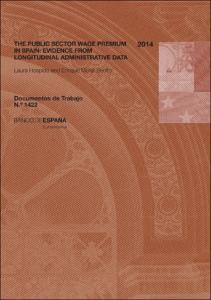The public sector wage premium in Spain : evidence from longitudinal administrative data
Authors
Issue Date
13-Aug-2014
Physical description
47 p. : gráf., tab.
Abstract
En este trabajo utilizamos datos administrativos para estudiar la brecha salarial entre empleados de los sectores público y privado en España, diferenciando por sexo, nivel de formación y tipo de contrato. Estimamos distribuciones salariales condicionadas por características observadas por separado para hombres y mujeres en el sector público y en el sector privado, y usamos la estructura longitudinal de los datos para controlar por la selección en inobservables. Encontramos una prima salarial positiva para hombres y mujeres en el sector público, incluso teniendo en cuenta las características y la selección en inobservables
la brecha salarial media incondicional de 35 puntos se reduce a 20 cuando tenemos en cuenta diferencias en las características observadas, y a 10 una vez se controla por la selección en inobservables. Por otro lado, encontramos una variación sustancial de la brecha a lo largo de la distribución salarial cuando controlamos por características. Esta variación, sin embargo, se ve compensada por patrones opuestos de selección en el sector público: mientras observamos una selección positiva en la parte inferior de la distribución salarial del sector público, los trabajadores de la parte superior de la distribución de dicho sector se seleccionan negativamente
This paper studies the public sector wage gap in Spain by gender, skill level and type of contract, using recent administrative data from tax records. We estimate wage distributions in the presence of covariates separately for men and women in the public and in the private sectors, and we take advantage of the longitudinal structure of the data to control for selection. We find a positive public wage premium for men and women even after accounting for characteristics and endogenous selection
the observed average gap in hourly wages of 35 log points is reduced to 20 when accounting for observed characteristics, and to 10 once endogenous selection is also taken into consideration. We also find substantial variation in the public premium along the wage distribution once observed characteristics are accounted for. This variation, however, is offset by opposite patterns of selection into the public sector: while we observe positive selection into the public sector at the bottom of the wage distribution, workers at the top of the distribution select negatively into the public sector
la brecha salarial media incondicional de 35 puntos se reduce a 20 cuando tenemos en cuenta diferencias en las características observadas, y a 10 una vez se controla por la selección en inobservables. Por otro lado, encontramos una variación sustancial de la brecha a lo largo de la distribución salarial cuando controlamos por características. Esta variación, sin embargo, se ve compensada por patrones opuestos de selección en el sector público: mientras observamos una selección positiva en la parte inferior de la distribución salarial del sector público, los trabajadores de la parte superior de la distribución de dicho sector se seleccionan negativamente
This paper studies the public sector wage gap in Spain by gender, skill level and type of contract, using recent administrative data from tax records. We estimate wage distributions in the presence of covariates separately for men and women in the public and in the private sectors, and we take advantage of the longitudinal structure of the data to control for selection. We find a positive public wage premium for men and women even after accounting for characteristics and endogenous selection
the observed average gap in hourly wages of 35 log points is reduced to 20 when accounting for observed characteristics, and to 10 once endogenous selection is also taken into consideration. We also find substantial variation in the public premium along the wage distribution once observed characteristics are accounted for. This variation, however, is offset by opposite patterns of selection into the public sector: while we observe positive selection into the public sector at the bottom of the wage distribution, workers at the top of the distribution select negatively into the public sector
Publish on
Documentos de Trabajo / Banco de España, 1422
Subjects
Brecha salarial del sector público; Regresión cuantílica; Distribución salarial; Datos de panel; Public sector wage gap; Quantile regression; Wage distribution; Panel data; Modelos econométricos uniecuacionales y multiecuacionales; Funcionarios; Diferencias salariales por sectores; España
Appears in Collections:












